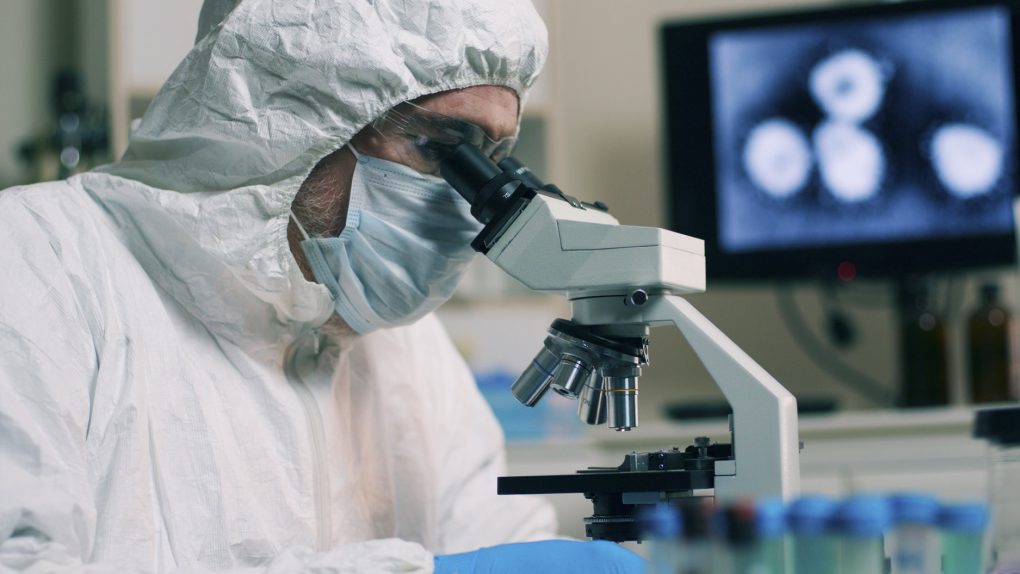- A massive study from Houston details a coronavirus mutation that makes the virus more infectious than other strains.
- This may sound like a scary development for an illness that’s already terrifying, but the research details the same dominant mutation that other scientists have already been observing for quite some time.
- Called D614G, the tiny genetic change affects the spike protein the virus uses to infect cells in the human body.
A virus might not have a mind of its own, but like any living thing, it tries to survive at all costs. To do so, it seeks out suitable hosts and then replicates itself using cells in the body. The resulting copies infect neighboring cells, and the process restarts. But accidents can happen during that replication process that lead to imperfect copies of the original virus. Even a small genetic change allows the virus to mutate into a different strain that behaves differently.
The novel coronavirus is no different. It uses the spike protein to latch on to cells and once the link-up is completed, the virus starts replicating. Like other viruses, the coronavirus has seen its fair share of mutations. A massive study from the US says that one such change allowed the virus to adapt to the current landscape and become even more infectious than the original. That sounds scary, but the good news is that we’re still looking at the same widespread mutation that other papers have been detailing for many months.
Researchers from the Houston Methodist Hospital sequenced more than 5,000 samples of the novel coronavirus from patients in Houston, concluding that the vast majority of those were the so-called D614G version of the virus. The scientists published their findings in pre-print form, as detailed by The Washington Post, which means the data hasn’t been reviewed by any peers.
What is interesting about this new study is that it details the same D614G mutation that health officials discovered in Asia not so long ago. It’s the same mutation that health experts like Dr. Anthony Fauci addressed in the past. It’s the same mutation that others detailed in spring, saying that it might have made the virus more infectious than before, although all these papers made it clear that the transformation doesn’t make the virus more deadly than before.
The D614G name comes from the actual genetic change that happens. An amino acid known as aspartic acid (D) replaces glycine (G) in the region of the genome that codifies the spike protein.
As with previous studies on this particular mutation, some say the finding is relevant while others say that more research is still required. Both are correct. It’s important to know what strains of COVID-19 are circulating in communities in order to assess whether vaccines and other drugs can neutralize them. But research can’t stop because the virus will continue to mutate. And it may be true that other factors have increased the transmissibility of the illness, not just the D614G change.
Virologist David Morens from the National Institute of Allergy and Infectious Diseases — and senior adviser to Dr. Fauci — said that the findings point to the strong possibility of the virus adapting as it moves through the population. This “may have implications for our ability to control it,” the doctor told The Post while cautioning that the study shouldn’t be over-interpreted. The virus could be responding to our defenses, he speculated.
“Wearing masks, washing our hands, all those things are barriers to transmissibility or contagion, but as the virus becomes more contagious, it statistically is better at getting around those barriers,” he said. This line of thinking further underscores the importance of observing safety measures that can reduce the spread of an infectious illness like COVID-19. There’s no way to prove that face masks have forced the virus to mutate, as the virus doesn’t have a mind of its own. It might be just a genetic accident.
But other studies have speculated that whatever happened, D614G seems to latch to human cells more efficiently, which gives it a better chance to infect cells and to replicate. Therefore, patients infected with this coronavirus strain might produce more copies of the virus that could end up in the air via aerosols and saliva droplets and infect more people. The more people are infected with D614G, the faster it propagates. The Houston study made the same observations.
The researchers explained how the virus affected Houston neighborhoods by analyzing genetic data. The virus arrived in Houston at separate times, by air travel at first. Some 71% of the patients who were studied were infected with the D614G mutation, which appears to have originated from China. The Post also cites an even larger study from the UK that looked at 25,000 genomes. The D614G was again identified as the mutation that made the virus more contagious.
The D614G mutation might be the most popular coronavirus mutation when it comes to genetic studies, but it’s hardly the only mutation the virus has undergone. The virus will continue to mutate and every infection allows it to change, at least in theory. Any replication mistake inside a host could give the virus new capabilities, but it could also create weaker strains of the virus.
Musser warned that scientists and officials involved in dealing with COVID-19 should prioritize genetic sequencing so that better conclusions can be drawn about the pathogen’s evolution.
One worry is that significant coronavirus mutations might give the virus flu-like behavior when it comes to vaccines. The flu shot offers limited protection each year because there are so many strains of the flu in the wild, and they continue to mutate. That’s why vaccines need to be adapted to match those changes every year. The good news is that there’s no indication the same thing is happening with COVID-19. The D614G change was first observed several months ago, and there’s no indication whatsoever that it will have an impact on vaccine efficacy. In other words, researchers have every reason to believe that vaccines currently in development will fight the D614G strain of the novel coronavirus just as well as other strains.








